TOYOTA TUNDRA 2021 Owners Manual (in English)
Manufacturer: TOYOTA, Model Year: 2021, Model line: TUNDRA, Model: TOYOTA TUNDRA 2021Pages: 612, PDF Size: 13.7 MB
Page 201 of 612
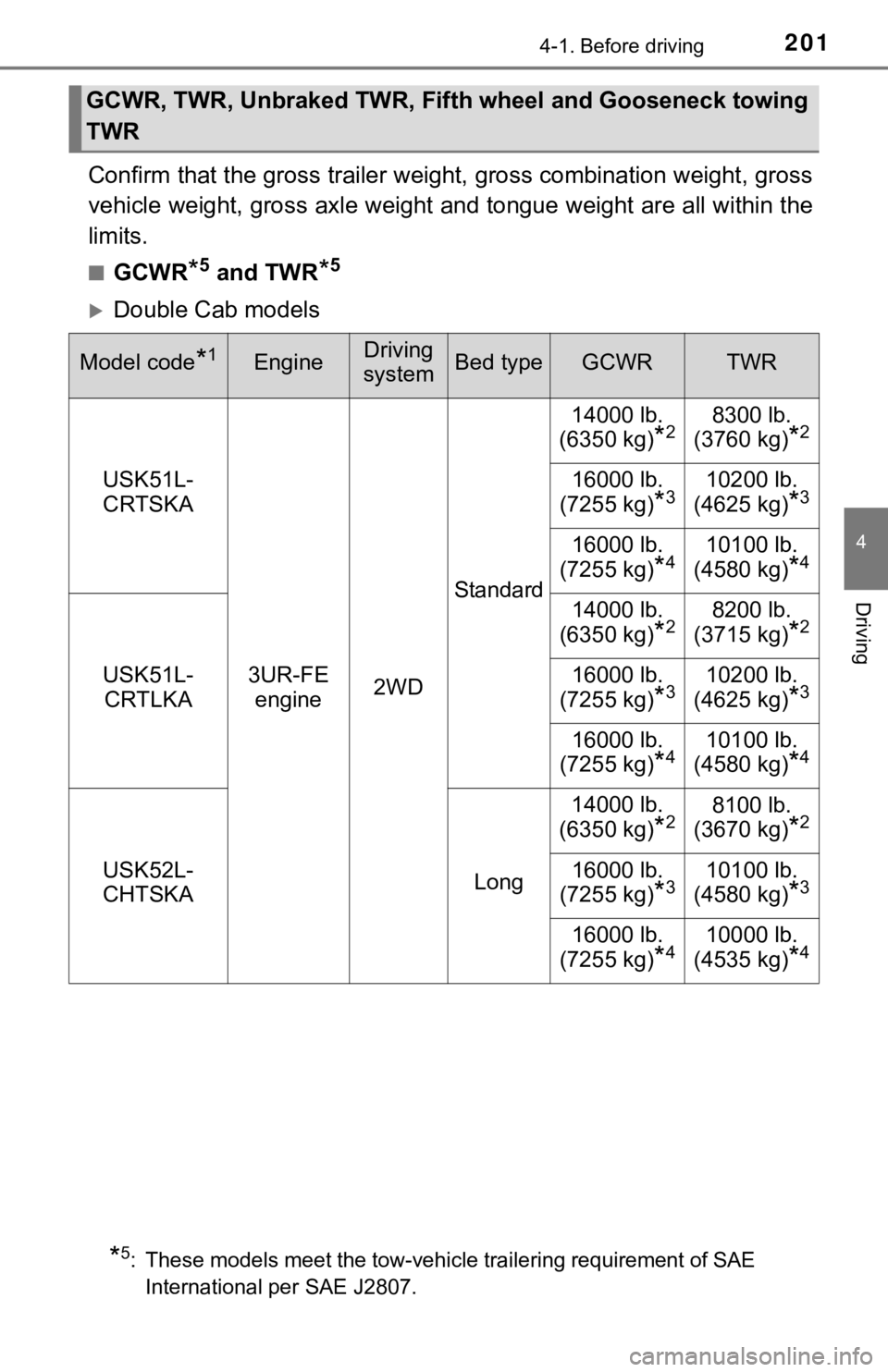
2014-1. Before driving
4
Driving
Confirm that the gross trailer weight, gross combination weight, gross
vehicle weight, gross axle weight and tongue weight are all within the
limits.
■GCWR*5 and TWR*5
Double Cab models
GCWR, TWR, Unbraked TWR, Fifth wheel and Gooseneck towing
TWR
*5: These models meet the tow-vehicle trailering requirement of SAE International per SAE J2807.
Model code*1EngineDriving
systemBed typeGCWRTWR
USK51L- CRTSKA
3UR-FE engine 2WDStandard 14000 lb.
(6350 kg)
*28300 lb.
(3760 kg)
*2
16000 lb.
(7255 kg)
*310200 lb.
(4625 kg)
*3
16000 lb.
(7255 kg)
*410100 lb.
(4580 kg)
*4
USK51L- CRTLKA 14000 lb.
(6350 kg)
*28200 lb.
(3715 kg)
*2
16000 lb.
(7255 kg)
*310200 lb.
(4625 kg)
*3
16000 lb.
(7255 kg)
*410100 lb.
(4580 kg)
*4
USK52L-
CHTSKA Long14000 lb.
(6350 kg)
*28100 lb.
(3670 kg)
*2
16000 lb.
(7255 kg)
*310100 lb.
(4580 kg)
*3
16000 lb.
(7255 kg)
*410000 lb.
(4535 kg)
*4
Page 202 of 612
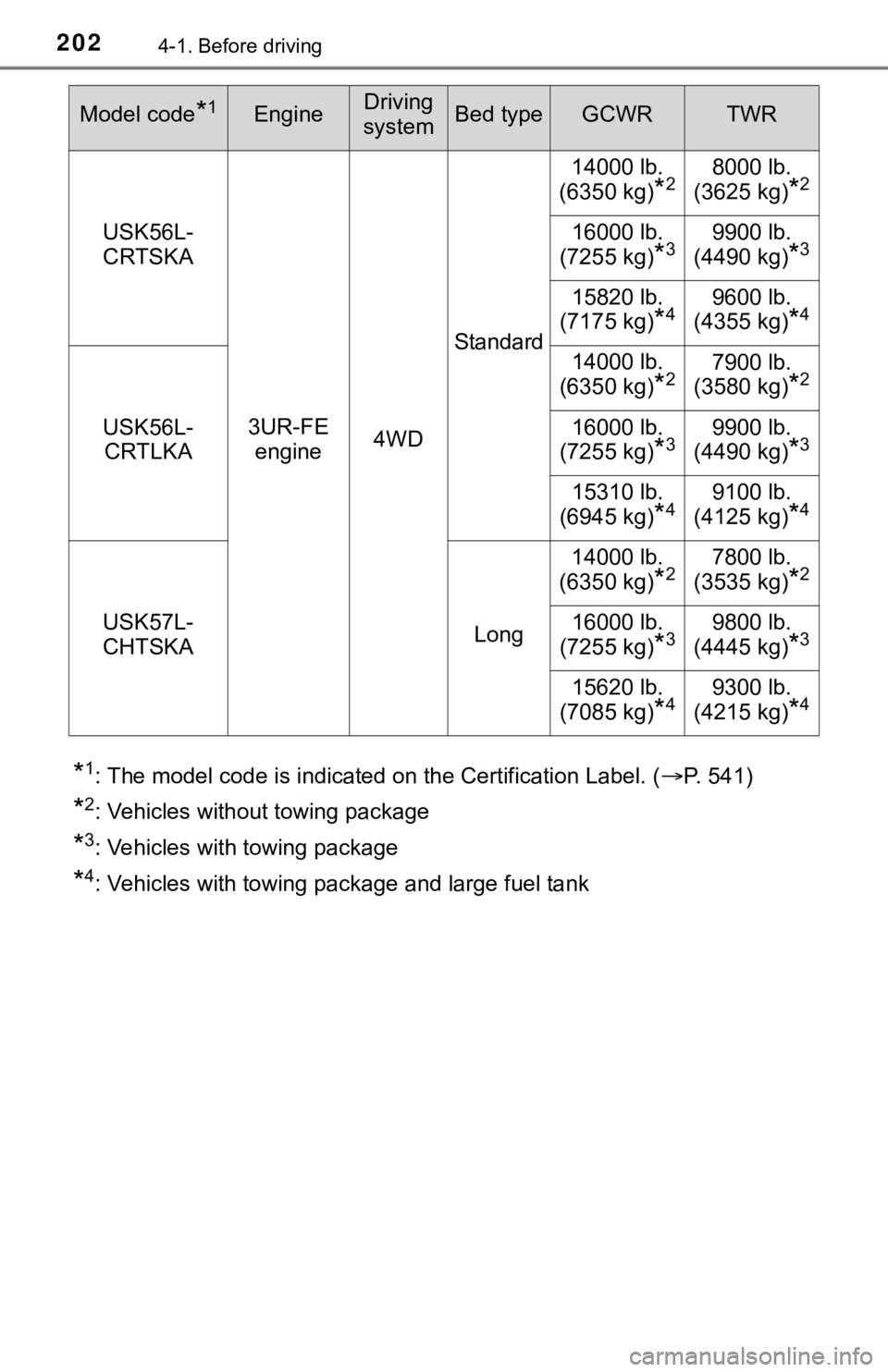
2024-1. Before driving
*1: The model code is indicated on the Certification Label. (P. 541)
*2: Vehicles without towing package
*3: Vehicles with towing package
*4: Vehicles with towing package and large fuel tankUSK56L-
CRTSKA
3UR-FE engine 4WDStandard 14000 lb.
(6350 kg)
*28000 lb.
(3625 kg)
*2
16000 lb.
(7255 kg)
*39900 lb.
(4490 kg)
*3
15820 lb.
(7175 kg)
*49600 lb.
(4355 kg)
*4
USK56L- CRTLKA 14000 lb.
(6350 kg)
*27900 lb.
(3580 kg)
*2
16000 lb.
(7255 kg)
*39900 lb.
(4490 kg)
*3
15310 lb.
(6945 kg)
*49100 lb.
(4125 kg)
*4
USK57L-
CHTSKA Long14000 lb.
(6350 kg)
*27800 lb.
(3535 kg)
*2
16000 lb.
(7255 kg)
*39800 lb.
(4445 kg)
*3
15620 lb.
(7085 kg)
*49300 lb.
(4215 kg)
*4
Model code*1EngineDriving
systemBed typeGCWRTWR
Page 203 of 612
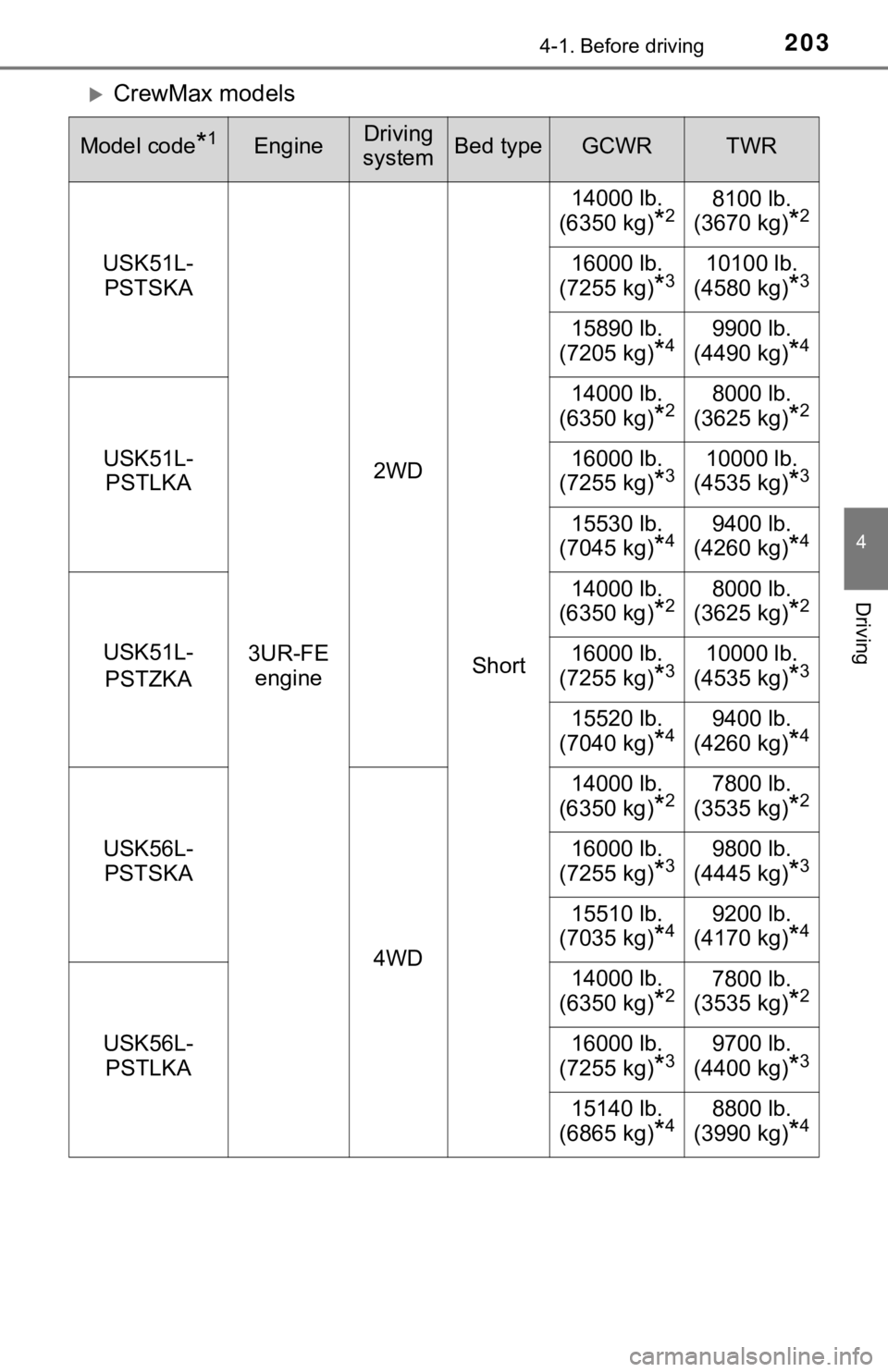
2034-1. Before driving
4
Driving
CrewMax models
Model code*1EngineDriving
systemBed typeGCWRTWR
USK51L- PSTSKA
3UR-FE engine 2WD
Short 14000 lb.
(6350 kg)
*28100 lb.
(3670 kg)
*2
16000 lb.
(7255 kg)
*310100 lb.
(4580 kg)
*3
15890 lb.
(7205 kg)
*49900 lb.
(4490 kg)
*4
USK51L- PSTLKA 14000 lb.
(6350 kg)
*28000 lb.
(3625 kg)
*2
16000 lb.
(7255 kg)
*310000 lb.
(4535 kg)
*3
15530 lb.
(7045 kg)
*49400 lb.
(4260 kg)
*4
USK51L-
PSTZKA 14000 lb.
(6350 kg)
*28000 lb.
(3625 kg)
*2
16000 lb.
(7255 kg)
*310000 lb.
(4535 kg)
*3
15520 lb.
(7040 kg)
*49400 lb.
(4260 kg)
*4
USK56L-
PSTSKA
4WD14000 lb.
(6350 kg)
*27800 lb.
(3535 kg)
*2
16000 lb.
(7255 kg)
*39800 lb.
(4445 kg)
*3
15510 lb.
(7035 kg)
*49200 lb.
(4170 kg)
*4
USK56L-
PSTLKA 14000 lb.
(6350 kg)
*27800 lb.
(3535 kg)
*2
16000 lb.
(7255 kg)
*39700 lb.
(4400 kg)
*3
15140 lb.
(6865 kg)
*48800 lb.
(3990 kg)
*4
Page 204 of 612
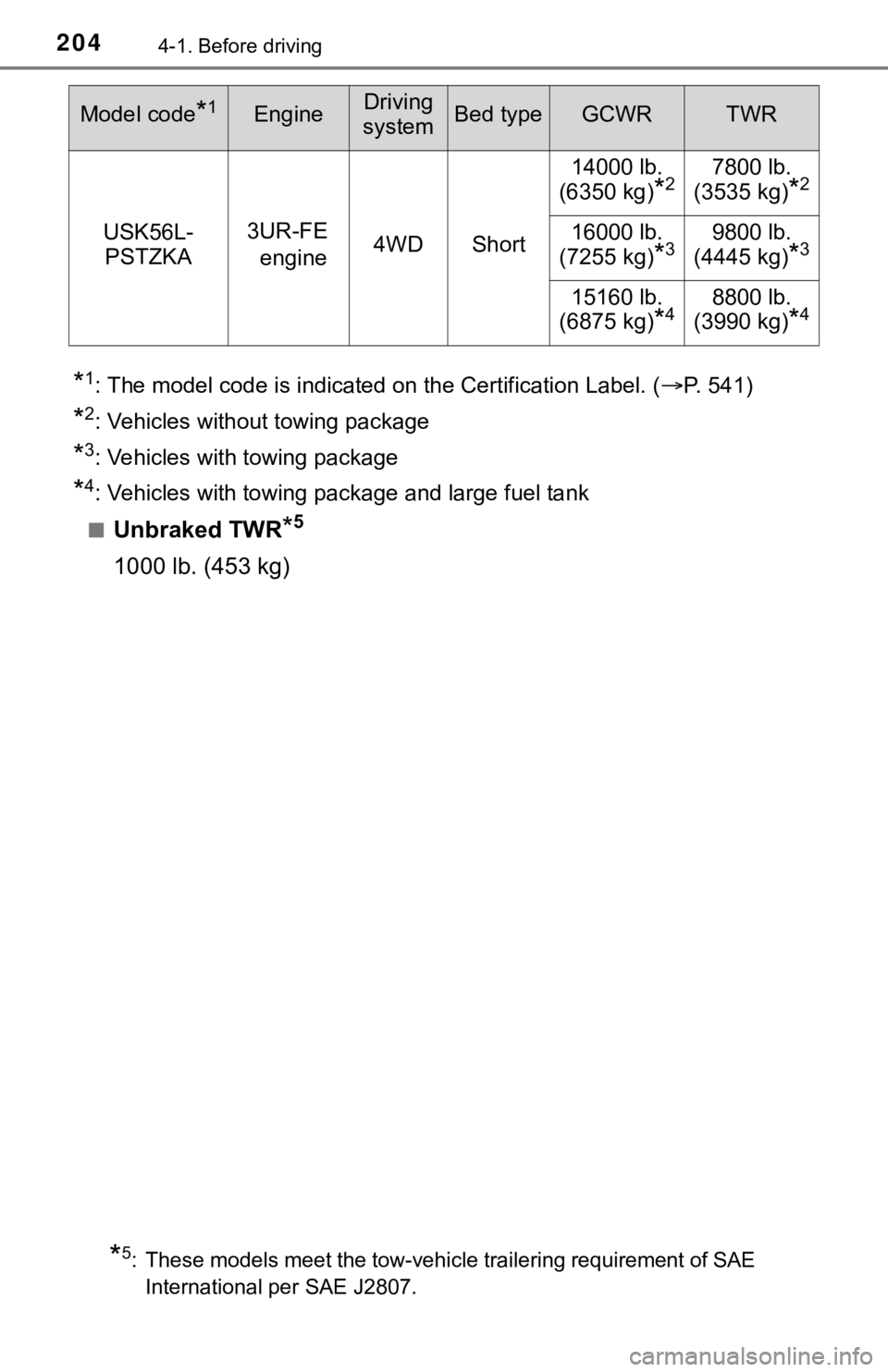
2044-1. Before driving
*1: The model code is indicated on the Certification Label. (P. 541)
*2: Vehicles without towing package
*3: Vehicles with towing package
*4: Vehicles with towing package and large fuel tank
■Unbraked TWR*5
1000 lb. (453 kg)
USK56L-
PSTZKA 3UR-FE
engine 4WD Short 14000 lb.
(6350 kg)
*27800 lb.
(3535 kg)
*2
16000 lb.
(7255 kg)
*39800 lb.
(4445 kg)
*3
15160 lb.
(6875 kg)
*48800 lb.
(3990 kg)
*4
*5: These models meet the tow-vehicle trailering requirement of SAE
International per SAE J2807.
Model code*1EngineDriving
systemBed typeGCWRTWR
Page 205 of 612
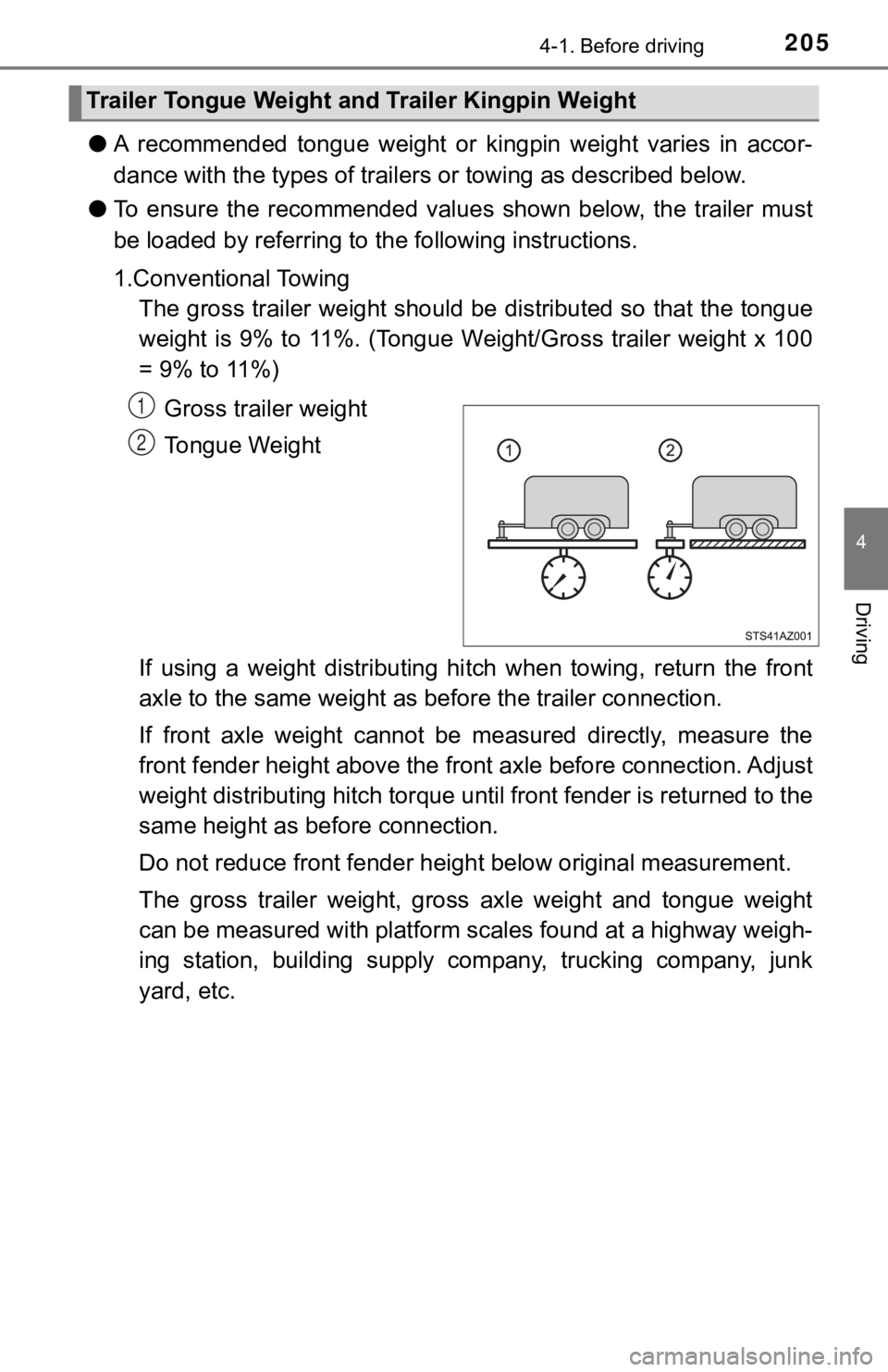
2054-1. Before driving
4
Driving
●A recommended tongue weight or kingpin weight varies in accor-
dance with the types of trailer s or towing as described below.
● To ensure the recommended values shown below, the trailer must
be loaded by referring to t he following instructions.
1.Conventional Towing The gross trailer weight should be distributed so that the tong ue
weight is 9% to 11%. (Tongue We ight/Gross trailer weight x 100
= 9% to 11%)
Gross trailer weight
Tongue Weight
If using a weight distributing hi tch when towing, return the front
axle to the same weight as b efore the trailer connection.
If front axle weight cannot be measured directly, measure the
front fender height above the front axle before connection. Adjust
weight distributing hitch torque until front fender is returned to the
same height as b efore connection.
Do not reduce front fender heigh t below original measurement.
The gross trailer weight, gross axle weight and tongue weight
can be measured with platform sca les found at a highway weigh-
ing station, building supply company, trucking company, junk
yard, etc.
Trailer Tongue Weight and Trailer Kingpin Weight
1
2
Page 206 of 612
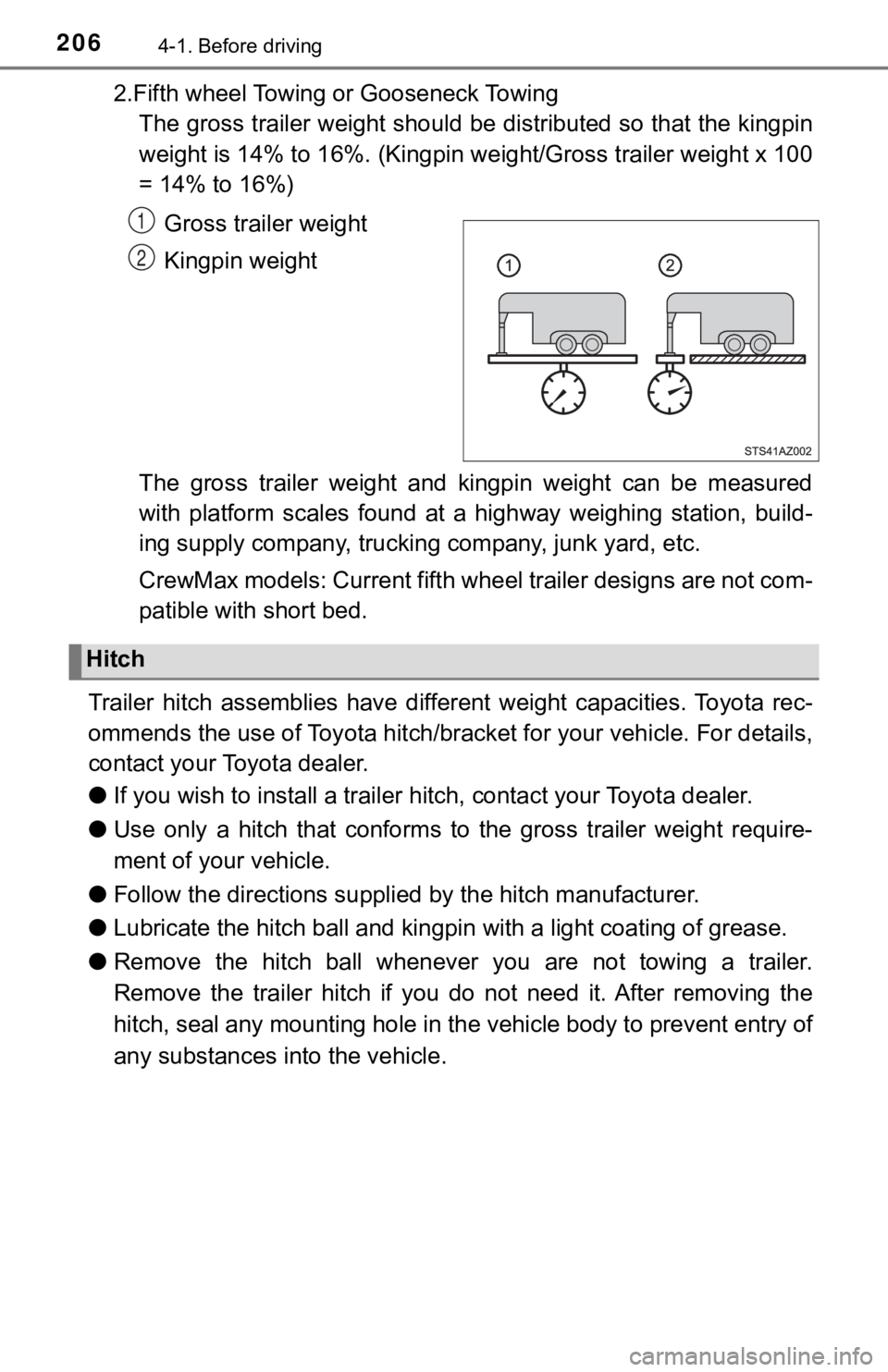
2064-1. Before driving
2.Fifth wheel Towing or Gooseneck TowingThe gross trailer weight should be distributed so that the king pin
weight is 14% to 16%. (Kingpin w eight/Gross trailer weight x 100
= 14% to 16%)
Gross trailer weight
Kingpin weight
The gross trailer weight and kingpin weight can be measured
with platform scales found at a h ighway weighing station, build-
ing supply company, trucki ng company, junk yard, etc.
CrewMax models: Current fifth wheel trailer designs are not com -
patible with short bed.
Trailer hitch assemblies have different weight capacities. Toyo ta rec-
ommends the use of Toy ota hitch/bracket for your vehicle. For d etails,
contact your Toyota dealer.
● If you wish to install a trailer hitch, contact your Toyota dea ler.
● Use only a hitch that conforms to the gross trailer weight requ ire-
ment of your vehicle.
● Follow the directions suppli ed by the hitch manufacturer.
● Lubricate the hitch ball and kingpin with a light coating of gr ease.
● Remove the hitch ball whenever you are not towing a trailer.
Remove the trailer hitch if you do not need it. After removing the
hitch, seal any mounting hole in the vehicle body to prevent en try of
any substances into the vehicle.
1
2
Hitch
Page 207 of 612
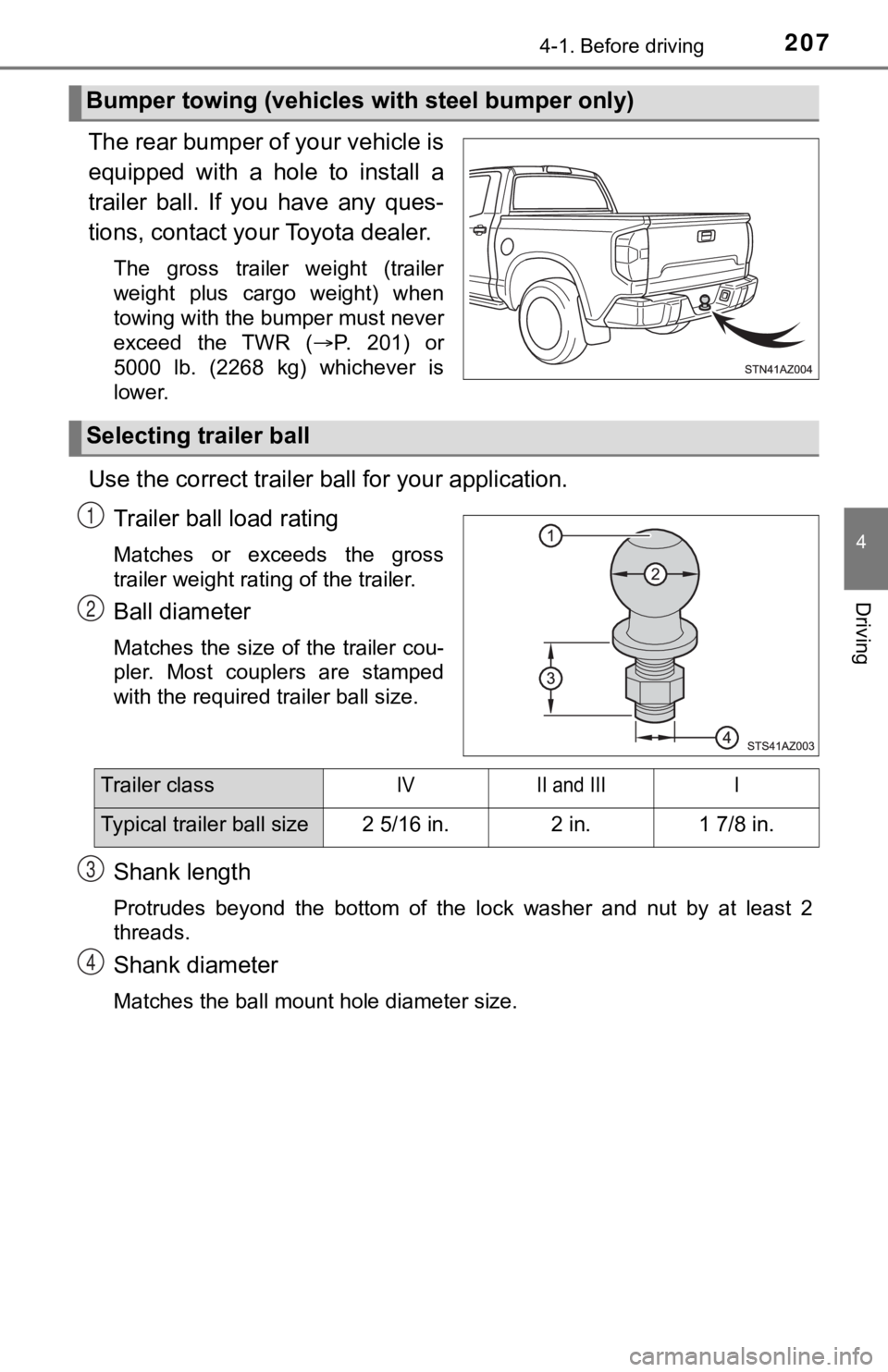
2074-1. Before driving
4
Driving
The rear bumper of your vehicle is
equipped with a hole to install a
trailer ball. If you have any ques-
tions, contact your Toyota dealer.
The gross trailer weight (trailer
weight plus cargo weight) when
towing with the bumper must never
exceed the TWR ( P. 201) or
5000 lb. (2268 kg) whichever is
lower.
Use the correct trailer ball for your application.
Trailer ball load rating
Matches or exceeds the gross
trailer weight rating of the trailer.
Ball diameter
Matches the size of the trailer cou-
pler. Most couplers are stamped
with the required trailer ball size.
Shank length
Protrudes beyond the bottom of the lock washer and nut by at le ast 2
threads.
Shank diameter
Matches the ball mount hole diameter size.
Bumper towing (vehicles with steel bumper only)
Selecting trailer ball
1
2
Trailer classIVII and IIII
Typical trailer ball size2 5/16 in.2 in.1 7/8 in.
3
4
Page 208 of 612
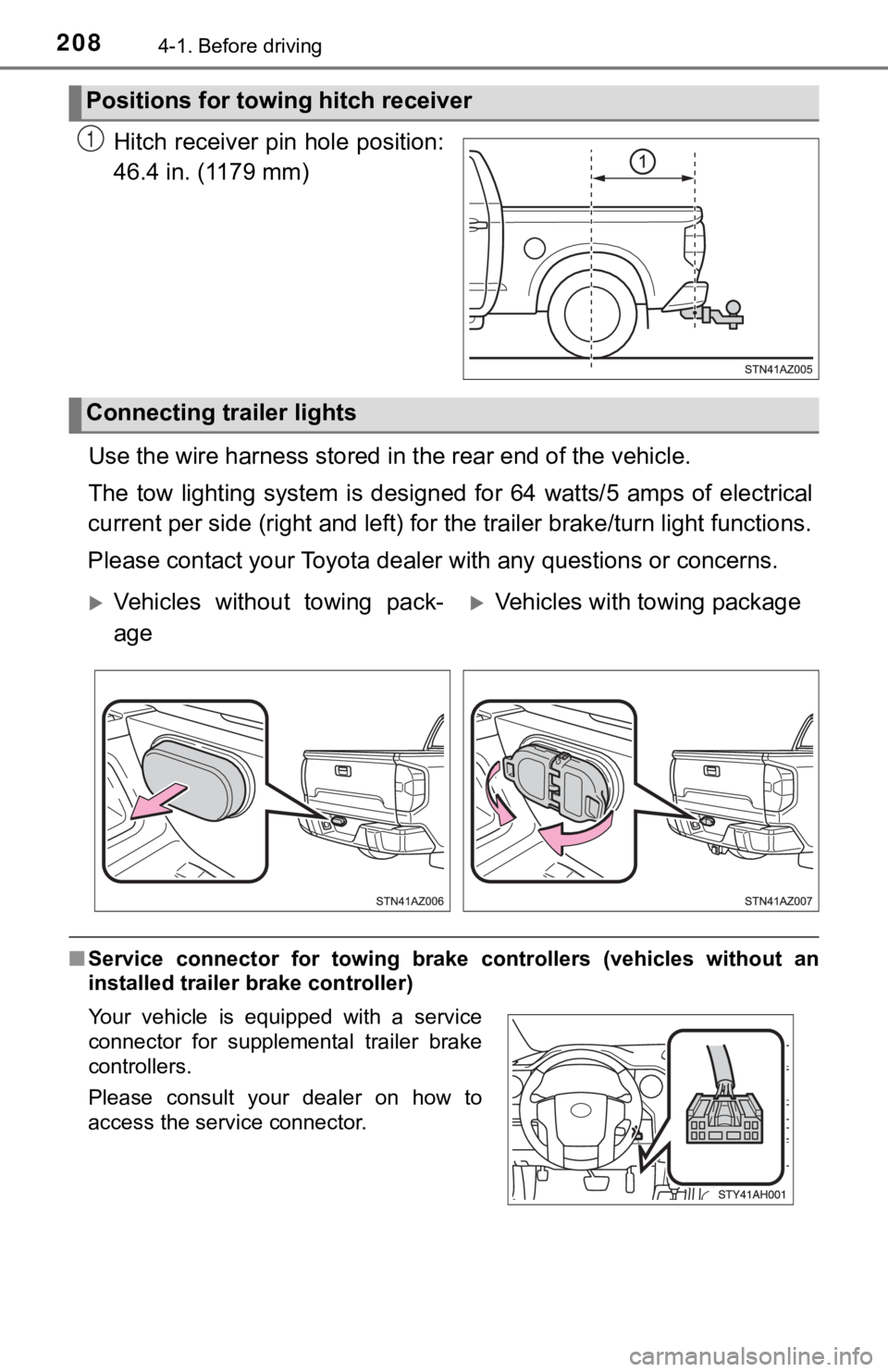
2084-1. Before driving
Hitch receiver pin hole position:
46.4 in. (1179 mm)
Use the wire harness stored in the rear end of the vehicle.
The tow lighting system is desi gned for 64 watts/5 amps of elec trical
current per side (right and left) for the trailer brake/turn li ght functions.
Please contact your Toyota dealer with any questions or concerns.
■Service connector for towing br ake controllers (vehicles without an
installed trailer brake controller)
Positions for towing hitch receiver
1
Connecting trailer lights
Vehicles without towing pack-
ageVehicles with towing package
Your vehicle is equipped with a service
connector for supplemental trailer brake
controllers.
Please consult your dealer on how to
access the service connector.
Page 209 of 612
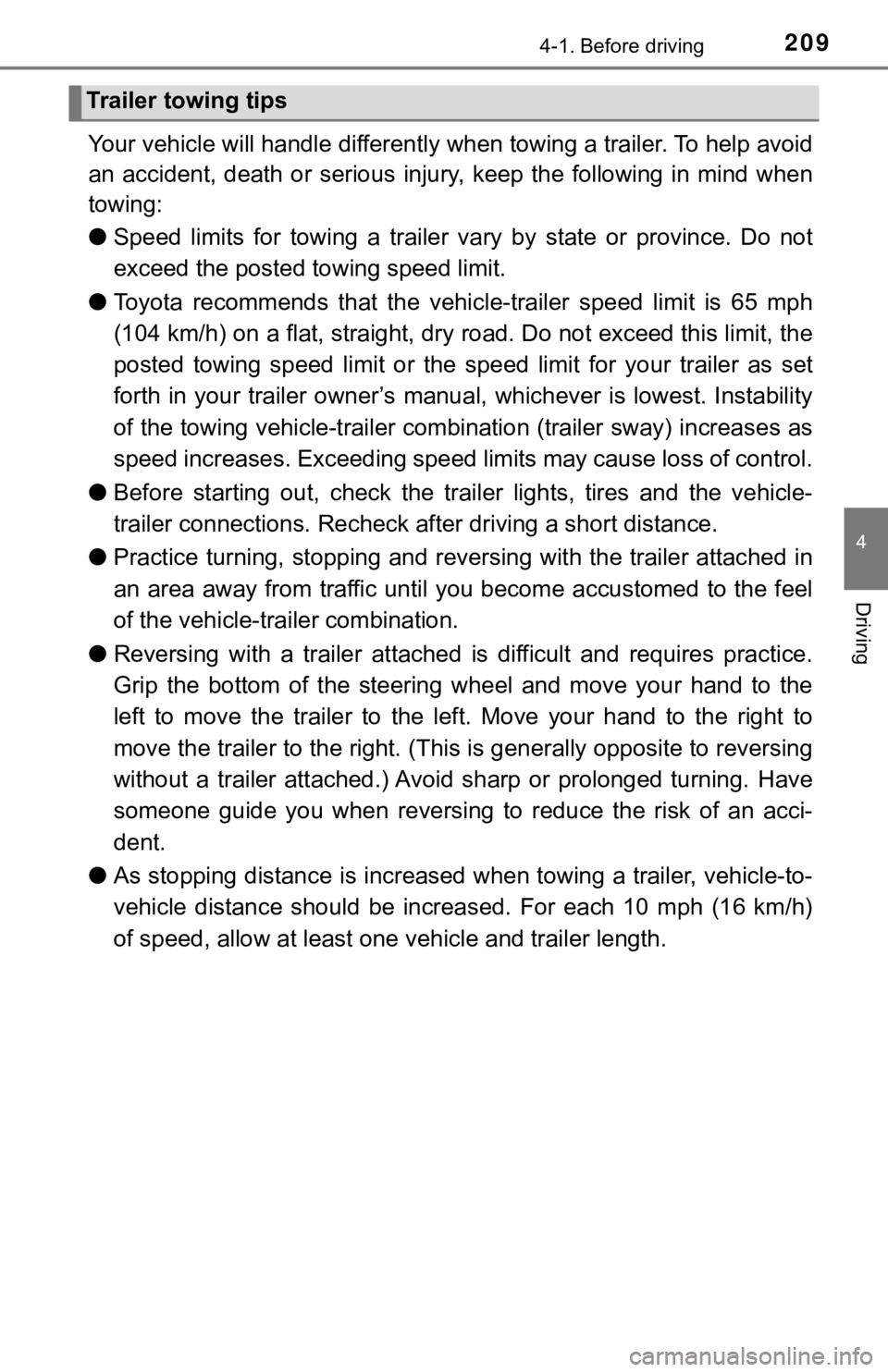
2094-1. Before driving
4
Driving
Your vehicle will handle differently when towing a trailer. To help avoid
an accident, death or serious injury, keep the following in min d when
towing:
● Speed limits for towing a trailer vary by state or province. Do not
exceed the posted to wing speed limit.
● Toyota recommends that the vehicl e-trailer speed limit is 65 mph
(104 km/h) on a flat, straight, dry road. Do not exceed this li mit, the
posted towing speed limit or the speed limit for your trailer a s set
forth in your trailer owner’s manu al, whichever is lowest. Instability
of the towing vehicle-trailer combination (trailer sway) increa ses as
speed increases. Exceeding speed limits may cause loss of contr ol.
● Before starting out, check the trailer lights, tires and the vehicle-
trailer connections. Recheck af ter driving a short distance.
● Practice turning, stopping and reversing with the trailer attac hed in
an area away from traffic until you become accustomed to the fe el
of the vehicle-trailer combination.
● Reversing with a trailer attached is difficult and requires pra ctice.
Grip the bottom of the steering wheel and move your hand to the
left to move the trailer to the left. Move your hand to the rig ht to
move the trailer to the right. (This is generally opposite to r eversing
without a trailer attached.) Avoid sharp or prolonged turning. Have
someone guide you when reversing to reduce the risk of an acci-
dent.
● As stopping distance is increased when towing a trailer, vehicl e-to-
vehicle distance should be increased. For each 10 mph (16 km/h)
of speed, allow at least one v ehicle and trailer length.
Trailer towing tips
Page 210 of 612

2104-1. Before driving
●Avoid sudden braking as you may skid, resulting in the trailer jack-
knifing and a loss of vehicle control. This is especially true on wet or
slippery surfaces.
● Avoid jerky starts or sudden acceleration.
● Avoid jerky steering and sharp turns, and slow down before maki ng
a turn.
● Note that when making a turn, the trailer wheels will be closer than
the vehicle wheels to the inside of the turn. Compensate by mak ing
a wider than normal turning radius.
● Slow down before making a turn, in crosswinds, on wet or slippe ry
surfaces, etc.
Increasing vehicle speed can destabilize the trailer.
● Take care when passing other vehicles. Passing requires consider-
able distance. After passing a vehicle, do not forget the lengt h of
your trailer, and be sure you have plenty of room before changi ng
lanes.
● To maintain engine braking efficiency and charging system perfo r-
mance when using engine braking, do not use the transmission in
D.
Transmission shift ra nge position must be in 4 in the S mode.
● Instability happens more frequently when descending steep or lo ng
downhill grades. Before descending, slow down and downshift. Do
not make sudden downshifts while descending steep or long down-
hill grades.
● Avoid holding the brake pedal down too long or applying the bra kes
too frequently. This could cause the brakes to overheat and result in
reduced braking efficiency.
● Due to the added load of the trailer, your vehicle’s engine may over-
heat on hot days (at temperatures over 85°F [30°C]) when drivin g
up a long or steep grade. If the engine coolant temperature gau ge
indicates overheating, immediately turn off the air conditionin g (if in
use), pull your vehicle off the road and stop in a safe spot.
( P. 529)